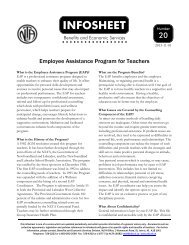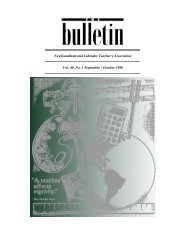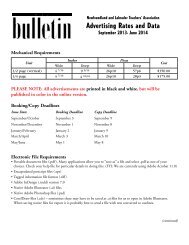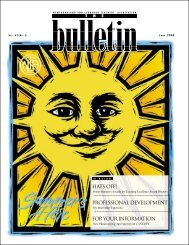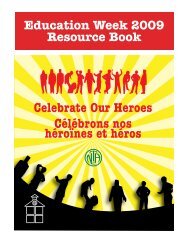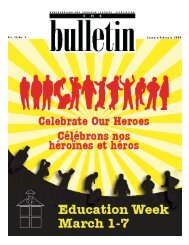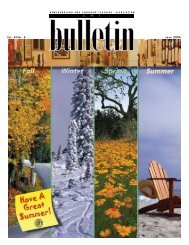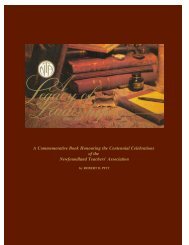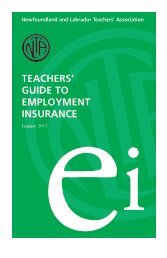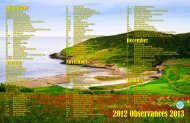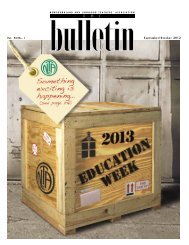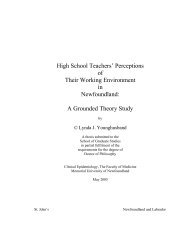Resource Book - Newfoundland and Labrador Teachers' Association
Resource Book - Newfoundland and Labrador Teachers' Association
Resource Book - Newfoundland and Labrador Teachers' Association
Create successful ePaper yourself
Turn your PDF publications into a flip-book with our unique Google optimized e-Paper software.
A Message to Teachers from NLTA President Lily B. Cole<br />
Dear Colleague,<br />
Education Week has always been about celebrating education <strong>and</strong> the importance of learning. This year’s theme, “I Think. I<br />
Can. – iThink. iCan! • Penser, c’est pouvoir. iPenser. iPouvoir!”, is broken down into separate sentences for emphasis <strong>and</strong> combined<br />
with the popularity of technological devices such as iPhones <strong>and</strong> iPads. The words of the philosopher Descartes’ famous<br />
quote “I think, therefore I am” also comes into play as does the children’s book “The Little Engine That Could”. By also using<br />
“I Think. I Can.” the theme will encompass other elements with three sub-themes of technology, community, <strong>and</strong> personal<br />
development.<br />
Education Week can be an enriching experience for students, teachers <strong>and</strong> parents. We encourage primary <strong>and</strong> elementary<br />
teachers to continue their practice of observing this week with their students. We especially encourage intermediate <strong>and</strong> high<br />
school students to become involved in the week as it presents an exciting opportunity to promote school spirit. Our students<br />
have much to contribute <strong>and</strong> would grow <strong>and</strong> learn from their involvement in Education Week activities.<br />
Our sincere thanks to all those who have assisted in planning the Education Week <strong>Resource</strong> Kit. We value the input of our fellow<br />
educators <strong>and</strong> assure you that your efforts are appreciated.<br />
We trust you will find this resource to be useful <strong>and</strong> that your activities during Education Week <strong>and</strong> every week of the school<br />
year are truly a celebration of education. Have a great week!<br />
Sincerely yours,<br />
Lily B. Cole<br />
President<br />
Table of Contents<br />
Using this <strong>Book</strong>let . . . . . . . . . . . . . . . . . . . . . . . . . .3<br />
Suggestions for Planning an Opening/Closing Ceremony . . . . .3<br />
Activities/Ideas<br />
• Community/la communauté . . . . . . . . . . . . . . . . . .4<br />
• Technology/la technologie . . . . . . . . . . . . . . . . . . 8<br />
• Personal Development/l’épanouissement personnel . . . . 10<br />
Suggested Web Sites . . . . . . . . . . . . . . . . . . . . . . . .15<br />
Activity Sheets . . . . . . . . . . . . . . . . . . . . . . . . . . .16<br />
Activity Sheet Answers . . . . . . . . . . . . . . . . . . . . . . . 22<br />
Education Week 2011 <strong>Resource</strong> <strong>Book</strong> 2
Using this <strong>Book</strong>let<br />
This Education Week resource booklet has been designed<br />
to provide a list of suggested activities, as well as some<br />
pages that can be photocopied <strong>and</strong> used in class or given<br />
to students to take home.<br />
The activities listed on the following pages are meant to<br />
provide ideas only – use any you feel might work, modify<br />
as you think best, or develop your own. To determine<br />
the grade level for which the activity is designed, check<br />
the letters listed by the title.<br />
P – Primary Students/Primaire (K-3)<br />
E – Elementary Students/Élémentaire (4-6)<br />
I – Intermediate Students/Intermédiaire (7-9)<br />
S – Senior High Students/Secondaire (10-12)<br />
Attention French teachers!<br />
The majority of the activities listed in the booklet can be<br />
adapted for French, English, or ESL students.<br />
Pour les professeurs de français<br />
La plupart des activités proposées dans ce livret peuvent<br />
être adaptées pour les élèves en français, en anglais et<br />
même en anglais langue seconde.<br />
The NLTA website contains a section about<br />
Education Week.<br />
It is located at www.nlta.nl.ca.<br />
Suggestions for Planning an<br />
Opening/Closing Ceremony<br />
Opening Ceremonies<br />
• Plan an assembly for your school.<br />
• Have your school choir or singing group sing the<br />
Education Week song or a medley of songs about the<br />
Education Week theme or one of its sub-themes.<br />
• Invite schools in your district to come together to<br />
plan an Opening Ceremony.<br />
• Invite community members, retired teachers, parents,<br />
etc. to take part in the Opening Ceremonies.<br />
• Set up a mural in each classroom or one for the<br />
entire school to display various activities completed<br />
during the opening <strong>and</strong> theme days throughout the<br />
week.<br />
• Have your Learning <strong>Resource</strong>s teacher set up a<br />
display of materials related to the Education Week<br />
theme.<br />
• Select a book or poem that you could read to the<br />
class on the day of the Opening Ceremonies.<br />
Closing Ceremonies<br />
• Have a closing assembly <strong>and</strong> put together a program<br />
of songs, dances, skits, role-plays etc. which students<br />
worked on throughout the week.<br />
• Invite parents to the celebration. Students can design<br />
their own invitations.<br />
• Set up displays (in your classroom or the school<br />
gymnasium) of the projects completed during the<br />
week <strong>and</strong> invite parents to come <strong>and</strong> view them.<br />
• Visit other classes in the school or visit another<br />
school in your area to see how others celebrated<br />
Education Week.<br />
• Throughout Education Week, have someone do a<br />
video tape or take pictures of various activities completed<br />
during the week. Have a popcorn party <strong>and</strong><br />
view the tape or pictures.<br />
3<br />
Education Week 2011 <strong>Resource</strong> <strong>Book</strong>
Activities/Ideas<br />
Community • la communauté<br />
A Better School (E, I, S)<br />
Students can collaborate on ways to improve the wellness<br />
of their school. They can submit their ideas to the<br />
school improvement committee, to the student council<br />
or the administration.<br />
A New Life (P, E, I, S)<br />
It’s the year 2055 <strong>and</strong> your class has been chosen to<br />
start a new life on a planet that’s just been discovered.<br />
Ask them to map out a plan for what they’ll need to<br />
prepare for <strong>and</strong> what they might want to avoid. Make<br />
sure they concentrate on the good things they want to<br />
accomplish.<br />
A Positive Environment (P, E, I, S)<br />
Create a display of photos that remind students about<br />
positive experiences, times of celebration or accomplishments.<br />
Discuss with the class how important a positive<br />
environment can be.<br />
Adopt-a-Spot (E, I, S)<br />
Have students identify potentially unsafe or neglected<br />
areas in their school, neighbourhood, or community,<br />
<strong>and</strong> work to improve them. They can clear the area of<br />
trash, remove graffiti, improve lighting, prune trees or<br />
shrubbery, <strong>and</strong> even create public art. Potential sites for<br />
improvement include a bus shelter, pedestrian walkway,<br />
a fence or a parking lot.<br />
Being Helpful (P, E)<br />
Do something helpful for someone in your family or in<br />
your community. Discuss it in class or write about it. You<br />
could hang the writing on “The Helping Tree” in your<br />
classroom.<br />
<strong>Book</strong> Drive (P, E, I, S)<br />
Students can organize a book drive to help stock the<br />
school or local public library. All students are asked to<br />
donate at least one book in good condition that they<br />
have enjoyed. Be sure to encourage the donation of all<br />
types of books.<br />
Buddy Reading (P, E)<br />
Pair older students with younger students in your<br />
school. The older student begins reading to the younger<br />
student. He/she could discuss the cover to predict what<br />
the story is about, pictures <strong>and</strong> relevance/clarity to the<br />
story. When finished reading, the older student can ask<br />
questions about the story. They can discuss if they like<br />
the story or not, <strong>and</strong> why. The activity finishes with the<br />
pair drawing an illustration to tell about the story.<br />
Buddy System (P, E, I, S)<br />
Have older students in your school become a buddy to<br />
younger students during Education Week. The students<br />
would spend recess <strong>and</strong> lunchtime with their buddies<br />
where the older student could have a fun game planned<br />
like “I Spy”, charades, an art activity, or reading together.<br />
Communication (P, E, I)<br />
Have students take turns being the “leader”, going to<br />
the front of the class to describe to the others a drawing<br />
which the rest of the class cannot see. Other students are<br />
asked to draw the image on their own paper according<br />
to the description spoken by the leader. Compare drawings<br />
when description is done. Repeat with 2-3 “leaders”.<br />
Discuss the need for leaders to explain things clearly to<br />
others.<br />
Community Helpers (P, E)<br />
Arrange an assembly for the school to honor community<br />
helpers that help in the school, like the nurse, the police,<br />
chair of the school council, volunteers <strong>and</strong> the like. Each<br />
grade should make one card to thank the particular<br />
community helper assigned to their class. Then in the<br />
assembly a student from that class presents the card to<br />
the community helper <strong>and</strong> thanks them on behalf of<br />
the school. If this assembly is arranged early enough in<br />
advance, the older students could write invitations to the<br />
community helper.<br />
Community History (P, E, I)<br />
Research the history of your community. Read about the<br />
first settlers, <strong>and</strong> the many changes that have taken place<br />
over the years. If possible, invite the mayor to speak to<br />
the class or take the class to visit the Town/City Hall.<br />
Education Week 2011 <strong>Resource</strong> <strong>Book</strong> 4
Connections (P, E, I, S)<br />
Invite a gr<strong>and</strong>parent or senior in the community to talk<br />
about growing up in <strong>Newfoundl<strong>and</strong></strong> <strong>and</strong> <strong>Labrador</strong> when<br />
they were young.<br />
Crafts <strong>and</strong> More (P E I S)<br />
Have people visit the school to demonstrate quilt making,<br />
net-making or other types of crafts <strong>and</strong> h<strong>and</strong>iwork<br />
from your community.<br />
Donation (P, E)<br />
Donate to the Food Bank or similar community service.<br />
Family Garage Sale (P, E)<br />
Design a brochure to advertise your family’s garage sale.<br />
Highlight items that show how your family members no<br />
longer require certain items because they have grown<br />
either physically or emotionally.<br />
Family Newspaper (P, E)<br />
Create a family newspaper or website that highlights<br />
your family’s growth. This could include headlines, articles<br />
<strong>and</strong> advertisements that pertain to both your family’s<br />
physical growth as well as how your family learns<br />
to work <strong>and</strong> live together.<br />
Family Trees (I, S)<br />
Have students research <strong>and</strong> complete as much of their<br />
family trees as possible.<br />
Field Trip (P, E)<br />
Organize a field trip to an educational setting in your<br />
community such as a fire station, museum, etc.<br />
Flea Market (P, E, I)<br />
Organize a school-wide flea market <strong>and</strong> have the students<br />
decide on which organization in their community<br />
should benefit from the fundraiser. Maybe there is a<br />
food bank, etc. Students need to realize that everyone<br />
needs to help each other in their community.<br />
Green Team (P, E, I, S)<br />
Have students start up a recycling project to help the<br />
environment – reduce, reuse, recycle. The project could<br />
be as simple as holding “Trashless Tuesdays” where<br />
5<br />
students try to reduce the amount of garbage they throw<br />
out at lunchtime, or you could hold a recycling day at<br />
your school to raise money. To introduce this activity<br />
you can have your class do a T- chart of the advantages<br />
of recycling <strong>and</strong> the disadvantages of not recycling. Or<br />
draw pictures explaining the advantages of recycling.<br />
The following day there should be an announcement<br />
telling all the students in the school the amount of<br />
money raised through the recycling <strong>and</strong> how it will be<br />
spent.<br />
Guess Where I Came From? (E, I)<br />
Ask students to interview their gr<strong>and</strong>parents (older relatives<br />
or friends) to see where their ancestors came from.<br />
They may share this information with their classmates.<br />
They may be surprised to find that their class has roots<br />
from the far corners of the world. What a connection!<br />
Helping Others (P, E, I)<br />
Invite someone from organizations such as UNICEF, Red<br />
Cross, etc. to talk about the work they perform to help<br />
others.<br />
I Love My School (E, I, S)<br />
Have students design a pamphlet, flyer or website outlining<br />
<strong>and</strong> highlighting positive aspects of their school or<br />
community.<br />
I’m Puzzling (E, I)<br />
On a sheet of 8 1/2 x 11 paper have students design<br />
a puzzle that contains seven pieces. In the pieces of<br />
the puzzle print the following: Favorite book; Favorite<br />
subject; I would like to be...; My hero; I’m good at...; My<br />
name; My family. Photocopy these onto white card stock.<br />
Have students fill in each piece <strong>and</strong> then cut the puzzle<br />
apart. Distribute puzzles around the class so that others<br />
can learn about their classmates.<br />
Local Music (P, E)<br />
Invite local musicians into your school to perform with<br />
<strong>and</strong> for the students. A question <strong>and</strong> answer session<br />
could follow to focus on their life, family roots, their<br />
musical training/schooling, etc.<br />
Education Week 2011 <strong>Resource</strong> <strong>Book</strong>
Media Critique (I, S)<br />
Have each student bring an interesting or appealing<br />
advertisement from a magazine to class. Divide the students<br />
into groups <strong>and</strong> have them discuss each advertisement<br />
<strong>and</strong> to which of the senses it most appeals. They<br />
should discuss whether or not it is a good ad <strong>and</strong> how<br />
the ad <strong>and</strong> other advertising affects our choices. Have<br />
them brainstorm the characteristics of an appealing<br />
print advertisement. They may also create their own ads<br />
to sell a product of their choice. Have students present<br />
their product <strong>and</strong> advertisement to the class.<br />
My Community (S)<br />
Populations in many of our communities have been<br />
changing dramatically in recent years. Some communities<br />
have been losing people, whereas others are growing.<br />
Contact your town hall <strong>and</strong> find statistics showing:<br />
a) population, b) number of housing starts, c) number<br />
of business applications, <strong>and</strong> d) tax revenue for the past<br />
ten years. Use bar graphs to show housing starts <strong>and</strong><br />
business applications <strong>and</strong> a line graph for tax revenue.<br />
Use the population numbers <strong>and</strong> graphs to determine if<br />
your town is in a period of growth or decline. Use graphing<br />
calculators where possible. Interview your mayor or<br />
have him/her come to your class to discuss the impact<br />
(positive or negative) of the changes which have taken<br />
place in your community in the past ten years. What has<br />
the Town/City Council done to deal with these changes?<br />
Further statistical information about your community<br />
may be found at: http://ceps.statcan.ca/english/profil/<br />
PlaceSearchForm1.cfm<br />
My Family (P, E, I, S)<br />
Have students bring in something from home (ex.: quilt)<br />
<strong>and</strong> show to class. They can tell a story about the object,<br />
answering questions like: What is it? Who does it belong<br />
to? How does it celebrate their family?<br />
Part of My Community (E, I, S)<br />
Have students research a volunteer group in their city/<br />
town. They can make a pamphlet educating people on<br />
why this group is important to the community.<br />
Peace in My Community (P, E, I)<br />
Have students think of a person they admire who often<br />
tries to help people cooperate. This could be a teacher,<br />
coach, or church leader. Have them make a list of this<br />
person’s positive qualities <strong>and</strong>/or write a note to this person<br />
to express their appreciation to him or her for working<br />
at keeping the peace.<br />
People Working Together (P E)<br />
Make a collage of pictures of people in a community<br />
who work together to help us.<br />
Read In (P E)<br />
Invite local writers to the school to read with the students.<br />
Students can read a book by a local author or<br />
the teacher can choose a “read-aloud” book from this<br />
category.<br />
Saltwater Joys (P, E, I, S)<br />
No matter where <strong>Newfoundl<strong>and</strong></strong>ers <strong>and</strong> <strong>Labrador</strong>ians<br />
move to live <strong>and</strong> work, they always consider<br />
<strong>Newfoundl<strong>and</strong></strong> <strong>and</strong> <strong>Labrador</strong> to be home. Have students<br />
create a web of reasons why. Have students listen to the<br />
song “Saltwater Joys”, written by Wayne Chaulk of Buddy<br />
Wasisname <strong>and</strong> the Other Fellers. Write a journal entry<br />
responding to the song.<br />
Saving the Planet (P, E)<br />
Encourage students to express their feelings about the<br />
environment. Students will learn that nature can be a<br />
source of inspiration <strong>and</strong> it should be protected. Have students<br />
draw a picture, write a poem or short story about an<br />
environmental issue, e.g. global warming, the rainforest.<br />
Special People (P E I S)<br />
Invite parents, gr<strong>and</strong>parents, the mayor, senior citizens,<br />
or speakers on special topics to share stories, experiences,<br />
etc. with the students in your class.<br />
St<strong>and</strong>ing Up For Your Beliefs (S)<br />
Have your students prepare a persuasive speech about<br />
their right to an education, the Charter of Rights <strong>and</strong><br />
Freedoms, the Rights of the Child, or a topic of their<br />
choice concerning fundamental rights <strong>and</strong> freedoms.<br />
Education Week 2011 <strong>Resource</strong> <strong>Book</strong> 6
The Little Engine That Could (I, S)<br />
“The Little Engine That Could” is a well-known children’s<br />
story about the power of perseverance <strong>and</strong> the<br />
power that positive messages have in supporting perseverance.<br />
Divide the class into several student teams.<br />
Each team will create a motto or slogan that will help<br />
encourage others to achieve their goals. Goals might<br />
include: academic improvement, winning a competition<br />
(athletics, b<strong>and</strong>, etc.), self improvement (controlling<br />
anger, losing weight, etc.), avoiding peer pressure (drugs,<br />
sex, crime), relationship improvements (family, friends,<br />
etc.), getting a job, etc. Teams will design an advertising<br />
campaign to promote their perseverance message at<br />
school. Have each team present or “pitch” their ideas to<br />
the class or to a neighboring class. Select one campaign<br />
to propose to the student leadership council as a school<br />
spirit campaign.<br />
The Walking School Bus (P, E, I, S)<br />
Start a walking school bus program in your community.<br />
Responsible older students would follow a designated<br />
route to school <strong>and</strong> pick up younger students along the<br />
way.<br />
They Can Do It, Why Can’t I? (E, I, S)<br />
Have students research someone who has turned their<br />
life around, i.e. adopted a healthier lifestyle (e.g. became<br />
more active). Students can look at what motivated this<br />
person <strong>and</strong> how they were able to achieve their goal(s).<br />
Track Meet (P, E, I, S)<br />
Have older students organize a track meet for younger<br />
students in your school. They can set up routes, start <strong>and</strong><br />
finish lines; get judges <strong>and</strong> timers; create sign-up sheets<br />
<strong>and</strong> pass out information. On the day of the ‘meet’ allow<br />
students to run the fun day. (Variation: older students<br />
can organize a sports day for younger students.)<br />
Tutoring (E, I, S)<br />
Find individual students who might be interested in<br />
tutoring younger students in various subject areas.<br />
Arrange with a teacher from a younger grade for some<br />
of your students to come <strong>and</strong> help with any problems<br />
they might be having.<br />
7<br />
Volunteerism (P, E, I, S)<br />
Have students visit a senior’s home or hospital in your<br />
community. Students could entertain the seniors/<br />
patients, read to them, wrap gifts, or play cards <strong>and</strong><br />
other games. Perhaps this could become a regular event<br />
for the class.<br />
What Concerns You? (P, E, I, S)<br />
Have students discuss an issue which is important to<br />
their school or local community (or province). Have<br />
them write a letter to the town council, or MHA, voicing<br />
the concerns of the class. After students have discussed<br />
the issue, have them ask other students if they would<br />
like to sign the letter (as a petition).<br />
Who Am I? (P, E)<br />
Have students dramatize people working at different<br />
occupations. Other students have to guess the occupation,<br />
as in a “Who Am I” game.<br />
Education Week 2011 <strong>Resource</strong> <strong>Book</strong>
Technology • la technologie<br />
At Your Fingertips (P, E, I, S)<br />
The world is at our fingertips. If something newsworthy<br />
happens half way around the world, we know about<br />
it almost immediately. During Education Week, have<br />
students read through the paper or browse the web <strong>and</strong><br />
create either a bulletin board or poster of headlines<br />
from around the world.<br />
Celebrating Change (P, E, I, S)<br />
Have students invite guests to your school to talk about<br />
things from the past, how their customs <strong>and</strong> habits have<br />
changed through the years, <strong>and</strong> how today wouldn’t be<br />
today if it weren’t for yesterday. Typical questions to ask<br />
could include:<br />
• Where did you go to school?<br />
• How did you get to school each morning?<br />
• How many students were in your class?<br />
• Describe your desks, pencils, <strong>and</strong> paper.<br />
• Where was your library?<br />
• How did you do research?<br />
• How did you view educational films/videos?<br />
Education Obstacles (E, I, S)<br />
Have students reflect on obstacles students from 50<br />
years ago may have encountered in their attempt to<br />
complete their formal education. Have them research<br />
the “obstacles” <strong>and</strong> determine if they still exist today.<br />
E- environment/E-wasted (E, I, S)<br />
Have students research <strong>and</strong> investigate the components<br />
of common technological devices. They may also<br />
research the path of old, worn-out technology to the<br />
recycle center or garbage disposal. What is the impact<br />
on the environment? Create some public awareness to<br />
this issue.<br />
E-Pals (E, I, S)<br />
Make contact with a school in another country (use<br />
www.epals.com to make the contact). Have your students<br />
use email (they can word process the content <strong>and</strong><br />
you can send it if the class does not have its own email<br />
address) to exchange greetings with the students in the<br />
other class. Have your students tell them about their<br />
school <strong>and</strong> community. Have them ask about the other<br />
students’ school <strong>and</strong> community.<br />
E-tally (P, E, I)<br />
Survey the class <strong>and</strong> discover how your students use<br />
technology. They can create a pie chart, bar graph, etc.<br />
of the most common uses of technology, or the amount<br />
of time engaged with technology.<br />
Evaluating Web Pages (E, I)<br />
The Internet offers a wealth of information to students,<br />
but much of the information is misleading or incorrect.<br />
Anyone can publish a page on the Internet. They do not<br />
have to go through any editing as you would when writing<br />
a book. Students need to be taught how to critically<br />
evaluate a website. There are many sites that offer guidelines<br />
for you such as www.lib.berkeley.edu/TeachingLib/<br />
Guides/Internet/Evaluate.html. Pre-select a couple of<br />
web pages for your students to evaluate. As a group go<br />
over the evaluations <strong>and</strong> discuss.<br />
Future Innovations (E, I, S)<br />
Have students speculate on possible innovations that<br />
will occur in schools by the year 2025.<br />
Getting the Message (E, I, S)<br />
Have students brainstorm all the ways we use technology<br />
with others. Have them arrange their list according<br />
to the ways they think are most important to least<br />
important. They should share their list with the class<br />
<strong>and</strong> discuss their choices.<br />
Invention Inventory (P, E, I, S)<br />
Have students in your class take inventory of things<br />
in their homes that wouldn't have existed 30, 40 or 50<br />
years ago. Have students compare how this has affected<br />
the way of life in our province.<br />
Making History (E, I, S)<br />
Have students draw a cartoon of a historical character<br />
making a momentous discovery. They could indicate in<br />
a speech balloon what the individual might have said at<br />
that particular moment (i.e. Marconi receiving the first<br />
wireless message).<br />
Education Week 2011 <strong>Resource</strong> <strong>Book</strong> 8
Old vs. New (E, I, S)<br />
Have students compare the physical realities of the classroom<br />
in the past with that of the present. <strong>Resource</strong>s: old<br />
textbooks, old photographs, old report cards, interviews, etc.<br />
(This activity <strong>and</strong> any material gathered will form the basis<br />
of student writing in the areas of dramas, short stories, essays,<br />
<strong>and</strong> poetry in English, reports in the area of culture, etc.)<br />
On the Net (E, I, S)<br />
Have students develop a web page about their school, or<br />
education in the past, present <strong>and</strong> future.<br />
Past Inventions (E, I, S)<br />
Have students write an advertisement for an invention<br />
that was developed in the past.<br />
Positive Partnerships (P, E, I)<br />
Partner with another school in our province through<br />
either the Internet, letter writing or actual visits. Share<br />
ideas about how to help make our school <strong>and</strong> community<br />
great places to live, work <strong>and</strong> learn. Involve students<br />
in a class discussion of their ideas.<br />
Technology <strong>and</strong> Me (P, E, I, S)<br />
Have students identify the ways they use technology at<br />
home, at school <strong>and</strong> at play. Do they think their lives are<br />
better because of the technology they use in their lives?<br />
Involve students in a class discussion of their ideas.<br />
Techno Music (E, I, S)<br />
Ask your students to focus on music technology to identify<br />
how far music has come. A demonstration of the<br />
capabilities of the modern synthesizer could be arranged<br />
<strong>and</strong> compared with earlier models.<br />
The Effects of Computers (I, S)<br />
Have students write a research report on the “History of<br />
Computers”. Discuss how this technological advancement<br />
has both positive <strong>and</strong> negative consequences.<br />
This Old House (E, I, S)<br />
Have students compare <strong>and</strong> contrast a house of today<br />
with one of past years or centuries. How has the construction<br />
of houses changed? How have the wants/needs<br />
of families changed?<br />
9<br />
Wave of Information (E, I, S)<br />
Have students discuss how the reporting of natural<br />
disasters (i.e. Hurricane Igor, earthquake in Haiti) has<br />
changed since the <strong>Newfoundl<strong>and</strong></strong> tsunami in the 1930’s.<br />
Students can interview family members or friends that<br />
lived in <strong>Newfoundl<strong>and</strong></strong> during the time of this disaster<br />
<strong>and</strong> find out such things as how long it took for them<br />
to find out what had happened. They could reference<br />
Tsunami: The <strong>Newfoundl<strong>and</strong></strong> Tidal Disaster by local<br />
author Maura Hanrahan.<br />
What Would I Do Without... (P, E, I, S)<br />
Have students/teachers stop using all forms of modern<br />
technology for a day, e.g. calculators, computers,<br />
overheads, photocopiers, microwaves, etc. Discuss the<br />
impact this may have on daily living.<br />
Education Week 2011 <strong>Resource</strong> <strong>Book</strong>
Personal Development •<br />
l'épanouissement personnel<br />
10 Good Things About Being a Friend (P,<br />
E)<br />
Read the story “The Tenth Good Thing About Barney”<br />
by Judith Viorst. Discuss with the class the importance<br />
of doing good things – being a good friend. Have your<br />
students sit in a circle <strong>and</strong> have them each take turns<br />
saying one good thing about the person sitting to<br />
their left. When completed, brainstorm the qualities of<br />
a good friend. Record the responses on the board or<br />
chart paper. Then have students create a poster titled,<br />
“The ten good things about being a friend”.<br />
A Day on the Job (I, S)<br />
Arrange for students to enter the workforce for one day<br />
or part of a day or have students <strong>and</strong> teachers change<br />
roles … where a principal or teacher can swap places<br />
with a student.<br />
A “Me” Collage (P,E, I)<br />
A collage is a dynamic art process. Have students create<br />
a collage that reveals who they are – what they like,<br />
things they have done, their family, etc. They may use<br />
various materials such as pictures, medals, trinkets,<br />
<strong>and</strong> other items that are important to them.<br />
Alike or Different? (E, I, S)<br />
Have students compare themselves to a character in<br />
a book or story they have read. Consider appearance,<br />
personality, interests, <strong>and</strong> the way they act. Have them<br />
list words they think about that describe a common<br />
quality <strong>and</strong> list words that describe different qualities.<br />
Did they realize something about themselves that they<br />
had not really thought about before?<br />
And the Award Goes To… (P, E, I, S)<br />
Develop a class awards program for perseverance.<br />
Students should nominate other students, a current<br />
public figure, <strong>and</strong> a historical figure who demonstrate<br />
perseverance. In the nomination itself, students must<br />
explain how each of the nominees exemplifies perseverance<br />
<strong>and</strong> why he or she deserves such recognition.<br />
Decide as a class how to best honor these individuals.<br />
Autobiographies (P, E, I, S)<br />
Have students write their own autobiographies. Have<br />
them include their own memories as well as information<br />
they gather from interviewing friends, relatives<br />
<strong>and</strong> even teachers.<br />
Bring It On (E, I, S)<br />
Have students make a list of negative <strong>and</strong> positive<br />
statements like “This is useless”, “There’s no hope”, or<br />
“I can do this” <strong>and</strong> “Bring it on”. Have them circle the<br />
ones that they know they need to say more often.<br />
Express Your Feelings (E, I, S)<br />
Have students begin each day with a journal entry that<br />
would only be read by the teacher with the student’s<br />
permission. In the journal, have students write how<br />
they coped or solved a problem. Have students write<br />
about their feelings at different stages in resolving<br />
the problem, especially if the problem is resolved. If<br />
a student is uncomfortable with this idea, they could<br />
respond to problems/difficulties characters are experiencing<br />
in books they are presently reading, telling how<br />
they would feel if they were the character or how they<br />
would try to solve the problem. The student could also<br />
write how a poem or story has made them feel.<br />
Fitness Plan (P, E, I, S)<br />
Have students make a list of physical activities they<br />
would enjoy doing. Have them create a fitness plan for<br />
each of the five days of Education Week, incorporating<br />
the activities they have chosen. Included in the fitness<br />
plan should be a goal they want to reach. Have them<br />
use a table with the following headings: Things That<br />
Will Motivate Me to Achieve My Goal; Barriers That<br />
Make It Hard for Me to Reach My Goal; <strong>and</strong> What I<br />
Can Do to Overcome the Challenges. Students may also<br />
want to include How I Know I Have Achieved My Goal<br />
<strong>and</strong> Length of Time Spent on the Activity Each Day.<br />
They can compare with other students.<br />
Education Week 2011 <strong>Resource</strong> <strong>Book</strong> 10
Good for Me! (P, E, I)<br />
Too often students forget about their own strengths <strong>and</strong><br />
focus on their weaknesses. Have students make a list of<br />
what they’re good at <strong>and</strong> then set aside time to share<br />
their special talents with classmates. You could also ask<br />
them to think of things they once found hard but now<br />
find easy – new skills they’ve learned, new strengths<br />
they’ve developed, new things they’ve discovered.<br />
Guess My Occupation (I, S)<br />
Have students research a particular career. Teachers may<br />
wish to provide a list of occupations/careers for students<br />
to use. Each student or pair of students writes five clues<br />
that describe the occupation (e.g. they might list the<br />
education requirements, tools used at work, etc.). The<br />
clues are listed from general to specific. In turns, each<br />
student reads their first clue. The first student to guess<br />
the occupation with one clue gets 25 points. If no one<br />
can guess from one clue, the next clue is read. Each clue<br />
read results in five marks deducted from the maximum<br />
score. The student with the highest score at the end of<br />
the game wins.<br />
How I Make Decisions (E, I)<br />
Have students think of a time when they had to make<br />
a choice between a healthy <strong>and</strong> unhealthy decision. For<br />
example, it is picture day at school <strong>and</strong> Stephanie wants<br />
to look her best. She has fixed her hair but she is still not<br />
happy with it. She has not yet had breakfast <strong>and</strong> is running<br />
out of time before she has to leave for school. She<br />
decides to skip breakfast so she can be happy with her<br />
appearance. Have students discuss what they would do<br />
in this type of situation. Was it a healthy decision? What<br />
could she have done to avoid the situation?<br />
How Often Do You Wash Your H<strong>and</strong>s? (E)<br />
Have students discuss what hygiene they practice <strong>and</strong><br />
why, with emphasis on dental hygiene, sharing combs<br />
<strong>and</strong> makeup. Now explain that students should keep a<br />
journal for two days that will be private. Next have them<br />
respond to their own journal. Do they feel they practice<br />
good hygiene? Do they need to change anything? Why do<br />
they feel they need to change?<br />
11<br />
How Well Do You Know Your Peers?<br />
(E, I, S)<br />
Ask students to write one fact about themselves that<br />
they feel most other students in the class would not<br />
know. Create a rubric for the class with these facts. Each<br />
student is to complete the sheet by finding a student to<br />
whom each fact applies <strong>and</strong> write his/her name in the<br />
block on the rubric. The object is to complete the rubric.<br />
This activity could be passed out on Monday to be passed<br />
in on Friday, rather than to use class time.<br />
I Think I Can, I Think I Can... (P, E, I, S)<br />
Have students engage in a new experience to help them<br />
develop a sense of accomplishment. They may find a talent<br />
they never knew they had. Some examples include<br />
beginning an exercise program, taking music lessons,<br />
reading a story.<br />
I Think I Can – I Know I Can (P, E)<br />
Create a chart. On one side write: I THINK I CAN; on the<br />
other side write: I KNOW I CAN. Have students come<br />
up with different examples (e.g. I think I can… tie<br />
my shoes by myself; be nice to my classmates; help my<br />
teacher tidy the classroom) <strong>and</strong> then sign their name on<br />
the chart when they have achieved a goal.<br />
http://atmybest.ca/teachers/emotional-health/kindergarten-activities<br />
I’m a Star (P, E)<br />
For self-esteem development, children need to feel important<br />
to both themselves <strong>and</strong> others. Have students talk<br />
about what they consider to be their best quality. This<br />
quality (e.g. I am a good friend) is put on a star. When all<br />
stars are completed they might be put on a blue bulletin<br />
board representative of a sky.<br />
Lend a H<strong>and</strong> (P, E, I, S)<br />
Have students offer to help someone each day during<br />
the week. It can be something simple from helping their<br />
little brother or sister tie their shoe to putting out the<br />
garbage without being asked. They can help someone<br />
they know with anything they need help with.<br />
Education Week 2011 <strong>Resource</strong> <strong>Book</strong>
Lessons in Life (I, S)<br />
The more students know about a given situation, the<br />
more information they will have to help come up with<br />
creative solutions for current problems that are inducing<br />
stress. Have them ask, “What can I learn from this experience?”<br />
Have students think of a situation that easily<br />
improves how they feel <strong>and</strong> have them write down the<br />
reasons why it makes them feel better.<br />
Let’s Break the Ice (I, S)<br />
If you have a group of students who are new to your<br />
school (i.e. Grade 7 students who have come to the<br />
school <strong>and</strong> are unfamiliar to the Grade 8s), this one<br />
can work. Students w<strong>and</strong>er around an open space, away<br />
from each other. A caller asks them to put up a h<strong>and</strong><br />
<strong>and</strong> raise between 1 - 5 fingers. Afterwards, students<br />
must locate another student with the same number of<br />
fingers up (but not from their own grade). When they<br />
pair up, students ask each other for their name, homeroom<br />
teacher <strong>and</strong> if they have any siblings. They then<br />
split up <strong>and</strong> w<strong>and</strong>er again. Caller repeats finger signal<br />
<strong>and</strong> new pairs ask each other for other items of information<br />
(beginning with names, though). Round continues<br />
until people get to know at least 4 - 5 new people.<br />
Let’s Talk (E, I, S)<br />
It often seems easy to help someone else find solutions<br />
to problems in life. Have students write an imaginary<br />
conversation they would have with a character from<br />
a book they have read. Have them offer the character<br />
advice about a problem. How did they feel about giving<br />
suggestions to another person/character?<br />
Making New Friends (P, E, I)<br />
Have each student interview a class member who they<br />
don’t usually spend time with. Have them find out their<br />
interests, favourite colour, food, activities, etc. This can<br />
be shared with the class, posted where others can read it<br />
or assembled in a book to be shared by the class.<br />
Me in the Year 2025 (E, I, S)<br />
Ask students to create an illustration or write a story<br />
about where they hope to be <strong>and</strong> what they hope to be<br />
doing in the year 2025.<br />
Me voici... en 2025 (E, I, S)<br />
Dem<strong>and</strong>ez aux élèves de faire un dessin ou d’écrire une<br />
histoire au sujet de ce qu’ils aimeraient faire ou quelle<br />
profession ils auront en 2025.<br />
Me Masks (E)<br />
Have students create masks using papier mache <strong>and</strong> a<br />
balloon. When the papier mache has dried have students<br />
prime the masks with white paint. Then ask them<br />
to decorate their mask to resemble themselves. They can<br />
use paint, markers, pictures, etc. Have students write a<br />
journal entry explaining why they decorated the masks<br />
the way they did. Also, have each student present their<br />
mask to the class <strong>and</strong> give a brief description of it.<br />
Outside Interests (P, E, I)<br />
Have students tell their classmates about a favourite<br />
hobby or other activity they’re involved in outside<br />
school. Students might want to describe something they<br />
learn at ballet or hockey, music or art class, or even talk<br />
about a project they are working on at home with a<br />
family member.<br />
Overcoming Obstacles (P, E, I, S)<br />
Have students research how people they know have<br />
overcome obstacles <strong>and</strong> reached their goals. These can<br />
include parents, friends, relatives, ancestors, or famous<br />
people. What were the obstacles? What steps did they<br />
take to overcome these obstacles?<br />
Perseverance (E, I, S)<br />
Have students define the word perseverance <strong>and</strong> discuss<br />
why it is important in reaching goals. Have students<br />
write acrostic poems using the word perseverance.<br />
Qualities that Count (E, I, S)<br />
Have students think about a person whom they admire<br />
<strong>and</strong> have them list the qualities that this person has that<br />
make him/her admirable. Have them ask, “Am I like<br />
this person? How?” <strong>and</strong> consider how they might try to<br />
improve themselves so that they, too, are an admired<br />
person.<br />
Reach Your Goals (P, E, I, S)<br />
Students should set a goal for the week <strong>and</strong> make sure<br />
Education Week 2011 <strong>Resource</strong> <strong>Book</strong> 12
they follow through on their goal. Have students seal<br />
their goals in an envelope to be opened on a certain date<br />
or at the end of the week.<br />
Remember When... (P, E, I)<br />
Have your students bring along pictures from home to<br />
create their own personal photo albums. Share the photo<br />
albums around the room. Make a display for parents. If<br />
students do not have photos to use, use clippings from<br />
magazines to create stories about their own lives (pets,<br />
games, parties, etc.) This activity could also be done as a<br />
timeline or a collage.<br />
Secret Helper (E, I, S)<br />
Put all student names in a bag. Each student draws out<br />
a classmate’s name. All week long that student becomes<br />
their “secret helper”. The secret helper secretly does nice<br />
things for their classmate (e.g. straightening their desk,<br />
bringing a small present each day, etc.). At the end of<br />
the week everyone tries to guess who their secret helper<br />
was. Anyone not identified will tell who they helped. To<br />
make it more difficult to be identified, the secret helper<br />
could get “caught” doing a nice thing for other students<br />
during the week.<br />
Setting Goals (E, I, S)<br />
Ask students to identify long <strong>and</strong> short term goals. Have<br />
them categorize their personal goals as short or long<br />
term.<br />
Sharing Life’s Experiences (P, E, I, S)<br />
Invite students to share some of the experiences of their<br />
everyday lives that might be very different from those of<br />
their classmates.<br />
Stories From Other L<strong>and</strong>s (E, I, S)<br />
Ask students from other places to share the story of their<br />
move with their classmates.<br />
Talent Show (P, E, I, S)<br />
Organize a talent show for the class <strong>and</strong>/or school.<br />
Encourage all students to participate. The talent show<br />
can encompass any type of talent that the students may<br />
have – singing, dancing, magic, gymnastics, etc.<br />
13<br />
The Little Engine That Could (P, E)<br />
Have students discuss the story "The Little Engine That<br />
Could" by Watty Piper (or a similar story about struggle<br />
<strong>and</strong> success) <strong>and</strong> then have them write a paragraph<br />
about a time they needed perseverance to succeed.<br />
The Meaning in a Name (P, E, I, S)<br />
Have students research the meaning of the family names<br />
of all the students in their class; have them find out<br />
where the name originated, etc.<br />
The Real You? (P, E, I)<br />
Have each student divide a sheet of paper into at least 14<br />
blocks. Have students write the letters of his/her name in<br />
each of the blocks. After decorating the blocks containing<br />
the letters, have students fill in the remaining boxes<br />
with designs that match their personality, hobbies, etc.<br />
Display the finished product on a bulletin board.<br />
Time to celebrate me! (P, E, I, S)<br />
Have students compile a list of ten things that they feel<br />
happy about themselves. Using the list they will create a<br />
collage/picture explaining the type of person they are.<br />
To Bully or Not to Bully, That is the<br />
Question (E, I)<br />
Have students collect information on bullying <strong>and</strong> its<br />
effect on students in the school. Using the information<br />
collected, they can write a script <strong>and</strong> perform a skit or<br />
play regarding bullying. Or have students role-play a<br />
bullying situation <strong>and</strong> how to deal with it. Then have the<br />
class discuss how they would have dealt with the same<br />
situation.<br />
Truly Unique (P, E)<br />
Have students explore the meaning of the word “unique”<br />
in a class discussion. As a class, they can draw a truly<br />
unique person. Each student draws only one feature on<br />
the person (example, one student draws the eyes, another,<br />
the nose, etc.). When the picture is complete the class<br />
can discuss the positive qualities of this person <strong>and</strong> how<br />
it’s what’s on the inside that counts.<br />
Education Week 2011 <strong>Resource</strong> <strong>Book</strong>
What Will I Be? (E, I, S)<br />
Have students develop a project on a chosen career <strong>and</strong><br />
identify steps to obtain employment in that particular<br />
field. The career possibilities, required skills <strong>and</strong> education,<br />
future trends <strong>and</strong> anticipated changes should be<br />
highlighted. They could share what they learned with<br />
others <strong>and</strong> develop a booklet, multi-media presentation,<br />
or web page.<br />
When I Grow Up (P, E)<br />
“When I grow up, I want to be …” Students could write<br />
an essay, a story, or even simply post their wishes on<br />
poster board or as signs around the school. Imagine the<br />
halls filled with a path of wishes that students could see<br />
everyday for the month of March.<br />
When I Look Inside Me... (E, I)<br />
When I look inside me... This is everything I see... Have<br />
students use these two lines as the start of a poem they<br />
finish <strong>and</strong> share with their classmates.<br />
Where Would We Be? (E, I, S)<br />
Ask students to develop a list of everything they would<br />
have difficulty doing in the run of a normal day if they<br />
couldn’t read or write. Then discuss ways students can<br />
get involved with literacy efforts.<br />
Wonderful Me (E, I)<br />
Have students write a journal entry or letter to themselves<br />
where they include only positive aspects <strong>and</strong><br />
things they do not want to change about themselves.<br />
This will encourage positive self-esteem.<br />
Words Will Break Your Heart (P, E, I, S)<br />
Pass out one sheet of paper to each student. Have students<br />
cut out a heart <strong>and</strong> write his/her name on it. Go<br />
around the class <strong>and</strong> have students think of one negative<br />
or hurtful thing another person has said to them.<br />
As each student says the negative thing, have students<br />
crumple up a little piece of their paper heart. After<br />
everyone, including the teacher, has said one negative<br />
comment he/she has heard, the paper hearts will<br />
be completely crumpled up. Then go around the class<br />
again, except this time, have students share a positive<br />
comment they’ve heard about himself/herself. After<br />
hearing each positive comment, gradually uncrumple<br />
the hearts <strong>and</strong> try to smooth them out. After everyone<br />
has given a positive comment, try to smooth the<br />
hearts out as much as possible. You will see that they’ll<br />
never be completely smooth again. Discuss how mean<br />
words leave scars in our hearts, just as they do with the<br />
wrinkles on the paper. Next, glue the paper hearts on<br />
a piece of tagboard. On the tagboard, write “Sticks <strong>and</strong><br />
Stones May Break Our Bones, but Words Will Break Our<br />
Hearts.” Hang it up in the front of the classroom as a<br />
constant reminder of the importance of being kind to<br />
each other.<br />
<strong>Book</strong> Suggestions for Perseverance<br />
Kindergarten:<br />
The Little Engine That Could, Watty Piper<br />
The Very Busy Spider, Eric Carle<br />
The Carrot Seed, Ruth Kraus<br />
Grade 1:<br />
Are You My Mother?, P.D. Eastman<br />
The Isty Bitsy Spider, Iza Trapani<br />
Turtles Race with Beaver, Joseph Bruchac<br />
Grade 2:<br />
Princesses Are Not Quitters, Kate Lum<br />
Tortoise <strong>and</strong> the Hare, Janet Stevens<br />
W<strong>and</strong>a's Rose, Pat Brisson<br />
Grade 3:<br />
Flossie <strong>and</strong> the Fox, Pat McKissack,<br />
I Have a Dream, Margaret Davidson<br />
Perseverance: The Story of Thomas Alva Edison,<br />
Peter Murray<br />
Grade 4:<br />
Amazing Grace, Mary Hoffman<br />
More than Anything Else, Marie Bradby<br />
Addy Saves the Day, Connie Rose Porter<br />
Grade 5:<br />
Wilma Unlimited, Kathleen Krull<br />
Fly, Eagle, Fly, Desmond Tutu<br />
I Knew You Could, Watty Piper<br />
Education Week 2011 <strong>Resource</strong> <strong>Book</strong> 14
Suggested Web Sites<br />
Top 4 Health Problems Caused by Computer<br />
http://heheli.com/business/top-4-health-problems-caused-bycomputer-use/<br />
Health Problems Related to the Geek Lifestyle<br />
www.tech-recipes.com/ rx/2639/debate_health_problems_related_geek_lifestyle/<br />
Children warned of net stranger danger<br />
http://news.bbc.co.uk/2/hi/health/678101.stm<br />
How to Stop Bullying<br />
www.how-to-stop-bullying.com/cyberbullying.html<br />
Internet Addiction Statistics: Facts,<br />
Figures & Numbers<br />
http://techaddiction.ca/internet_ addiction_statistics.html<br />
Are We Digital Dummies?<br />
www.cbc.ca/video/#/Shows/Doc_Zone/1242299559/<br />
ID=1651031614<br />
Web Aware - Cyberbullying<br />
www.bewebaware.ca/english/cyberbullying.html<br />
Television <strong>and</strong> Video Game Exposure <strong>and</strong> the<br />
Development of Attention Problems<br />
http://pediatrics.aappublications.org /cgi/reprint/<br />
peds.2009-1508v1<br />
Underst<strong>and</strong>ing Internet Addiction: Facts,<br />
Symptoms <strong>and</strong> Risks<br />
www.choosehelp.com/internet-addiction/underst<strong>and</strong>inginternet-addiction-facts-symptoms-<strong>and</strong>-risks.html<br />
Ontario Parents Try to Protect School Kids from<br />
Dangerous WiFi Rays<br />
http://blogs.discovermagazine.com/discoblog/2010/10/19/ontario-parents-try-to-protect-schoolkids-from-dangerous-wifi-rays/<br />
Safer Internet Day<br />
www.saferinternet.org/web/guest/safer-internet-day<br />
Cmap Tools: Mind mapping, group creation<br />
<strong>and</strong> collaboration<br />
http://cmap.ihmc.us/<br />
FreeMind: free mind mapping software<br />
http://freemind.sourceforge.net/wiki/index.php/Main_Page<br />
Webspiration<br />
www.mywebspiration.com/<br />
Mindmeister: online collaborative mind<br />
mapping tool<br />
www.mindmeister.com/<br />
XMind: brainstorming <strong>and</strong> mind mapping<br />
www.xmind.net/<br />
Open Office: an office suite compatible<br />
with Microsoft Office<br />
www.openoffice.org/<br />
GIMP (GNU Image Manipulation Program)–graphics<br />
www.gimp.org/<br />
Inkscape: Vector graphics<br />
www.inkscape.org/<br />
Blender: 2D & 3D content creation suite<br />
www.blender.org/<br />
NVU: web editor<br />
www.nvu.com/<br />
Audacity: sound editor<br />
http://audacity.sourceforge.net/<br />
ePortfolios: Why <strong>and</strong> How<br />
https://efolio.educ.ubc.ca/why<strong>and</strong>how/<br />
e-Portfolio module: A conceptual overview of<br />
the processes of developing an e-Portfolio<br />
www.cust.educ.ubc.ca/wstudents/tsed/modules/eportfolio/portfolio/index.html<br />
UBC Faculty of Education – examples of successful<br />
<strong>and</strong> effective ePortfolios by UBC’s Teacher<br />
C<strong>and</strong>idates<br />
https://efolio.educ.ubc.ca/examples/<br />
CommonCraft: Videos on Technology In Plain<br />
English<br />
www.commoncraft.com/<br />
eLearningLearning: A collection of blog posts<br />
<strong>and</strong> articles all around eLearning<br />
www.elearninglearning.com/<br />
Educators Reference Desk: articles, resources <strong>and</strong><br />
lesson plans<br />
www.eduref.org/<br />
15<br />
Education Week 2011 <strong>Resource</strong> <strong>Book</strong>
Looking for a Career? (E, I, S) (answers on page 22)<br />
S T E V S A V B R K S C D P S R P C Y I<br />
Q R M B W L Y O O T E U L C N S I P E K<br />
Z A P Z H F E N S P D A G D O M G W P O<br />
A I L S U I X E O S N G O L I J E F I S<br />
D N O G S E R T V S B C A I S R C N X M<br />
C I Y X U E W A T O C J S K I L L S Z A<br />
M N A K T I N W J U V I Z P C C K S M R<br />
U G B N F E D E P N O I S S E F O R P K<br />
S P I L O U R A R H G A T A D V Y V F E<br />
P D L G N X T O N A F I N A N C E S L T<br />
I O I G B I Y U L C W E R A P E R P E G<br />
B X T P O D M D R P E A C F E S M A S C<br />
Q T Y N J B O X R E X R A E X P T M E E<br />
G M G V P P N R I I G E S S X E K R O W<br />
L L Y K T M O C H D G A X F A I D Y Q B<br />
K A U L W A C H C B Z S Z M D O P Y Z E<br />
N C X K E A E A D E W J W I X V E J Q H<br />
A J Q U O F W S A Q L O T U B L H R A Z<br />
P G U E U Q I J U G R T R V K R X Q T J<br />
Y H V K J V X L H K M H O R O N Q H N Q<br />
aspire<br />
awareness<br />
decisions<br />
economy<br />
employability<br />
explore<br />
finances<br />
future<br />
GUIDANCE<br />
interests<br />
job<br />
life<br />
market<br />
occupation<br />
plans<br />
prepare<br />
profession<br />
self<br />
skills<br />
teamwork<br />
training<br />
work<br />
Education Week 2011 <strong>Resource</strong> <strong>Book</strong> 16
Personal Development Scramble (E, I, S) (answers on page 22)<br />
ICAHEVE<br />
USCCSSE<br />
GSOAL<br />
MAERD<br />
ETMARWKO<br />
OIRTTPYOPUN<br />
ELIBEEV<br />
EPETOCORA<br />
NECROAGUE<br />
TAIPCNEE<br />
TTRUS<br />
ARLEN<br />
TTEIDTAU<br />
ECCFONDEIN<br />
17<br />
Education Week 2011 <strong>Resource</strong> <strong>Book</strong>
Community Helpers (P, E) (answers on page 22)<br />
Across<br />
3. I drive kids to school every day.<br />
5. I bake food in the oven, like breads, cakes,<br />
<strong>and</strong> cookies.<br />
6. I care for your teeth <strong>and</strong> make sure you have<br />
a beautiful smile.<br />
8. I bring letters <strong>and</strong> packages to your home.<br />
Down<br />
1. I enforce laws <strong>and</strong> keep order.<br />
2. I put out fires <strong>and</strong> save people’s lives.<br />
4. I take care of animals.<br />
6. I can help you when you’re sick or hurt.<br />
7. I help you learn to read <strong>and</strong> write.<br />
9. I take care of libraries <strong>and</strong> help people find books.<br />
Education Week 2011 <strong>Resource</strong> <strong>Book</strong> 18
Learn Well Word Search (E, I) (answers on page 22)<br />
P R Q D Q D S E E W N L N M E<br />
R E Q K S I T L N J D S E R N<br />
I A V O G C B M W E T E E A I<br />
D L B O O A T R C I T L U O L<br />
E I Y V P L H I P S S K I T E<br />
W S M A V Q S Z E B B D H G M<br />
V T C G K I L F Q G N G O W I<br />
W I Y P O N L E H P E W S M T<br />
S C B N X E O X Z R P X D Q F<br />
A Y S Q S C B W H I Q Y A X L<br />
G N I K N I H T L A N R S Y D<br />
L O G I C A L R U E Q A J H M<br />
L O F P R I V D G I D N G X K<br />
C O N F I D E N C E R G K R W<br />
F P A F S K R E H T T Q E Y O<br />
CAPABLE<br />
CONFIDENCE<br />
DECISIONS<br />
KNOWLEDGE<br />
LOGICAL<br />
ORGANIZE<br />
PRIDE<br />
REALISTIC<br />
SELF ESTEEM<br />
THINKING<br />
TIMELINE<br />
WISDOM<br />
19<br />
Education Week 2011 <strong>Resource</strong> <strong>Book</strong>
Technology Scramble (E, I) (answers on page 22)<br />
Unscramble each of the clue words.<br />
Copy the letters in the numbered cells to other cells with the same number.<br />
ROWBESR<br />
MUCPEROT<br />
KOCFEABO<br />
DODWONAL<br />
MEORYM<br />
7<br />
5<br />
6<br />
TERNINTE<br />
NEORWTK<br />
VIURS<br />
TAOFWRES<br />
TACH<br />
1<br />
9<br />
4<br />
3 2<br />
8<br />
1 2 3 4 5 6 1 7 8 9<br />
!<br />
Education Week 2011 <strong>Resource</strong> <strong>Book</strong> 20
How Do I Feel? (P, E, I)<br />
Brainstorm <strong>and</strong> list as many feelings/emotions<br />
as you can on the board. Also include<br />
synonyms for the emotions (other words that<br />
describe the same feeling) <strong>and</strong> examples of<br />
things or events that cause these emotions.<br />
Discuss with students the various emotions<br />
<strong>and</strong> have students volunteer to role-play<br />
them. Discuss that different things make us<br />
feel different emotions. Have students choose<br />
four emotions to complete the web below.<br />
(Print the four emotions on the web. Then for<br />
each one, list at least three synonyms <strong>and</strong> in<br />
the other balloon give at least one example of<br />
something that makes them feel that way.)<br />
21<br />
Education Week 2011 <strong>Resource</strong> <strong>Book</strong>
Activity Sheet Answers/Clé de Réponses<br />
Looking for a career (page 16)<br />
S T E V S A V B R K S C D P S R P C Y I<br />
Q R M B W L Y O O T E U L C N S I P E K<br />
Z A P Z H F E N S P D A G D O M G W P O<br />
A I L S U I X E O S N G O L I J E F I S<br />
D N O G S E R T V S B C A I S R C N X M<br />
C I Y X U E W A T O C J S K I L L S Z A<br />
M N A K T I N W J U V I Z P C C K S M R<br />
U G B N F E D E P N O I S S E F O R P K<br />
S P I L O U R A R H G A T A D V Y V F E<br />
P D L G N X T O N A F I N A N C E S L T<br />
I O I G B I Y U L C W E R A P E R P E G<br />
B X T P O D M D R P E A C F E S M A S C<br />
Q T Y N J B O X R E X R A E X P T M E E<br />
G M G V P P N R I I G E S S X E K R O W<br />
L L Y K T M O C H D G A X F A I D Y Q B<br />
K A U L W A C H C B Z S Z M D O P Y Z E<br />
N C X K E A E A D E W J W I X V E J Q H<br />
A J Q U O F W S A Q L O T U B L H R A Z<br />
P G U E U Q I J U G R T R V K R X Q T J<br />
Y H V K J V X L H K M H O R O N Q H N Q<br />
Personal Development Scramble<br />
(page 17)<br />
1. ACHIEVE 2. SUCCESS<br />
3. GOALS 4. DREAM<br />
5. TEAMWORK 6. OPPORTUNITY<br />
7. BELIEVE 8. COOPERATE<br />
9. ENCOURAGE 10. PATIENCE<br />
11. TRUST 12. LEARN<br />
13. ATTITUDE 14. CONFIDENCE<br />
Community Helpers Crossword<br />
(page 18)<br />
Across<br />
Down<br />
3. Bus Driver 1. Police Officer<br />
5. Baker 2. Firefighter<br />
6. Dentist 4. Veterinarian<br />
8. Mailman 6. Doctor<br />
7. Teacher<br />
9. Librarian<br />
Learn Well Word Search (page 19)<br />
P R Q D Q D S E E W N L N M E<br />
R E Q K S I T L N J D S E R N<br />
I A V O G C B M W E T E E A I<br />
D L B O O A T R C I T L U O L<br />
E I Y V P L H I P S S K I T E<br />
W S M A V Q S Z E B B D H G M<br />
V T C G K I L F Q G N G O W I<br />
W I Y P O N L E H P E W S M T<br />
S C B N X E O X Z R P X D Q F<br />
A Y S Q S C B W H I Q Y A X L<br />
G N I K N I H T L A N R S Y D<br />
L O G I C A L R U E Q A J H M<br />
L O F P R I V D G I D N G X K<br />
C O N F I D E N C E R G K R W<br />
F P A F S K R E H T T Q E Y O<br />
Technology Scramble (page 20)<br />
1. BROWSER 2. COMPUTER 3. FACEBOOK<br />
4. DOWNLOAD 5. MEMORY 6. INTERNET<br />
7. NETWORK 8. VIRUS 9. SOFTWARE<br />
10. CHAT<br />
Solution: I THINK I CAN!<br />
Education Week 2011 <strong>Resource</strong> <strong>Book</strong> 22
What were they thinking?<br />
Computers in the future may weigh no more than 1.5 tons.<br />
– Popular Mechanics, forecasting the<br />
relentless march of science, 1949<br />
I think there is a world market for maybe five computers.<br />
– Thomas Watson, chairman of IBM, 1943<br />
This ‘telephone’ has too many shortcomings to be seriously considered as a<br />
means of communication. The device is inherently of no value to us.<br />
– Western Union internal memo, 1876<br />
The wireless music box has no imaginable commercial value. Who would pay for<br />
a message sent to nobody in particular?<br />
– David Sarnoff’s associates in response to his<br />
urgings for investment in the radio in the 1920s<br />
Who the hell wants to hear actors talk?<br />
– H.M. Warner, Warner Brothers, 1927<br />
Drill for oil? You mean drill into the ground to try <strong>and</strong> find oil? You’re crazy.<br />
– Drillers who Edwin L. Drake tried to<br />
enlist to his project to drill for oil in 1859<br />
Airplanes are interesting toys but of no military value.<br />
– Marechal Ferdin<strong>and</strong> Foch, Professor of Strategy,<br />
Ecole Superieure de Guerre<br />
Everything that can be invented has been invented.<br />
640K ought to be enough for anybody.<br />
– Charles H. Duell, Commissioner,<br />
U.S. Office of Patents, 1899<br />
– Bill Gates, 1981<br />
The concept is interesting <strong>and</strong> well-formed, but in order to earn better than a ‘C,’<br />
the idea must be feasible.<br />
– A Yale University management professor in response to Fred Smith’s<br />
paper proposing reliable overnight delivery service.<br />
(Smith went on to found Federal Express Corp.)
Designed <strong>and</strong> printed by NLTA Printing Services<br />
February 2011



